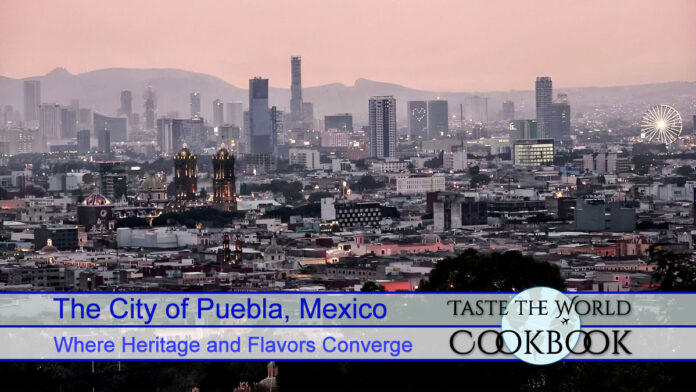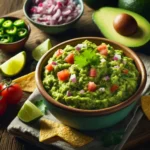Nestled in the heart of Mexico, Puebla is a city that enchants visitors with its rich history, vibrant culture, and unparalleled culinary delights. Often referred to as the “City of Angels,” Puebla captivates with its beautifully preserved colonial architecture, lively festivals, and world-famous cuisine, offering an experience that is both authentic and memorable.
- Table of Contents:
- The Charm of Puebla
- The History of Puebla
- FAQ
- Food From Puebla
The Charm of Puebla
Puebla’s streets are a living museum of colonial splendor, where baroque and neoclassical buildings line the cobblestone roads. The historic center, a UNESCO World Heritage site, showcases over 2,600 preserved structures, each telling a story of the city’s storied past. From the majestic Puebla Cathedral with its towering spires to the intricate facades of the Biblioteca Palafoxiana, the oldest public library in the Americas, the architectural beauty of Puebla is a testament to its rich cultural heritage.
Beyond its architectural wonders, Puebla’s cultural vibrancy is evident in its numerous festivals and traditions. The city comes alive with color and music during events like Cinco de Mayo, which commemorates the Battle of Puebla with parades, reenactments, and celebrations. The Day of the Dead, another significant festival, sees the city adorned with elaborate altars and offerings, honoring loved ones who have passed. These festivals are a vivid expression of Puebla’s deep-rooted traditions and communal spirit.
Puebla’s charm is also deeply intertwined with its culinary heritage. The city is a gastronomic paradise, celebrated for its unique blend of indigenous and Spanish influences. Iconic dishes such as mole poblano, a rich and complex sauce made with chocolate and chili peppers, and chiles en nogada, stuffed poblano chiles topped with a walnut sauce and pomegranate seeds, are just a few examples of Puebla’s culinary prowess. The flavors of Puebla are a delightful journey for the palate, making the city a must-visit destination for food lovers.
But Puebla’s allure goes beyond its historical and culinary attractions. The city’s vibrant markets, like El Parián Market and Mercado de Sabores Poblanos, offer a sensory feast with their array of local crafts, fresh produce, and traditional delicacies. Strolling through these markets provides a glimpse into daily life in Puebla and an opportunity to engage with the friendly and hospitable locals.
With its blend of historical grandeur, cultural richness, and culinary excellence, Puebla offers an enchanting experience that captivates the heart and soul. Whether you’re wandering through its historic streets, savoring its delectable dishes, or immersing yourself in its lively festivals, Puebla promises a journey that is both enriching and unforgettable.
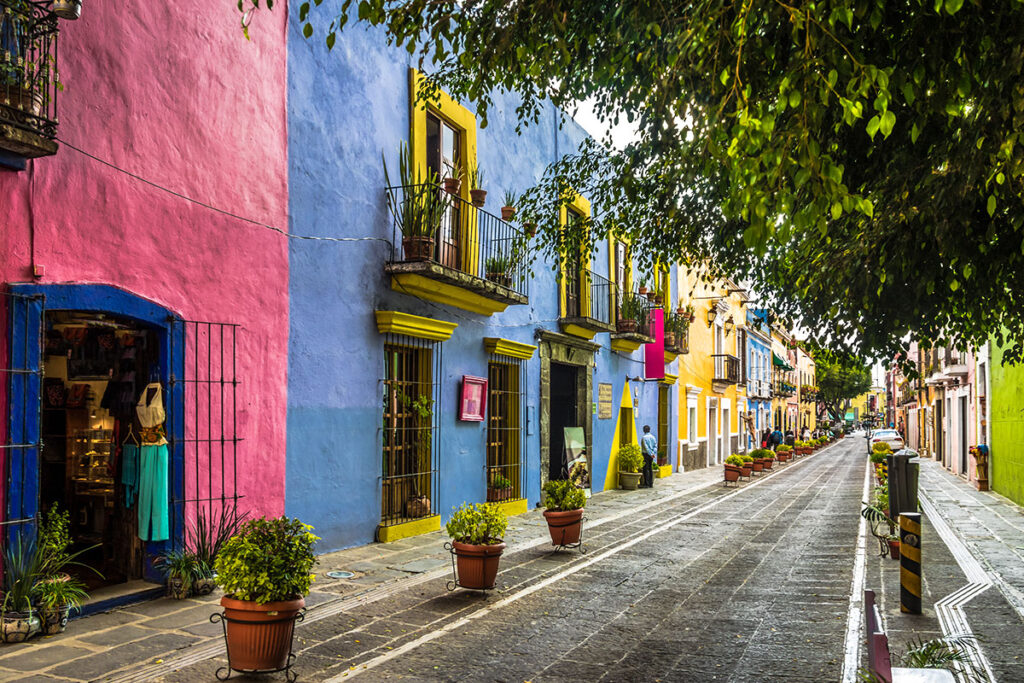
What State is the City of Puebla Located In?
The City of Puebla, officially known as Heroica Puebla de Zaragoza, is nestled in the heart of the state of Puebla. As the capital of the state, this vibrant city is not only a significant cultural and economic hub in central Mexico but also a gateway to the region’s rich history and traditions. Its strategic location has historically made it a key connector between the port city of Veracruz and Mexico City, contributing to its development and prosperity.
Puebla is renowned for its beautifully preserved colonial architecture, which tells the story of its Spanish colonial past. The city’s historic center, a UNESCO World Heritage site, is home to an array of baroque and neoclassical buildings that captivate visitors with their intricate designs and historical significance. These architectural gems, combined with Puebla’s lively markets and festivals, create a unique atmosphere that reflects the city’s blend of historical charm and modern vibrancy.
Beyond its architectural and cultural allure, the City of Puebla plays a crucial role in the state’s economy. It is a center for education, with several prestigious universities, and a hub for industries such as automotive manufacturing and food production. This dynamic blend of cultural heritage and economic vitality makes Puebla a fascinating destination for travelers and a thriving community for its residents.
What Are the Best Places to Eat?
Puebla is a culinary haven, offering a wide range of dining experiences that highlight its rich and diverse culinary traditions. From elegant restaurants serving gourmet cuisine to bustling markets filled with street food vendors, here are some of the best places to eat in Puebla:
El Mural de los Poblanos: Renowned for its authentic Poblano cuisine, El Mural de los Poblanos is a must-visit restaurant located in the heart of Puebla’s historic center. The menu features traditional dishes such as mole poblano, chiles en nogada, and tinga poblana, all prepared with fresh, local ingredients. The restaurant’s interior is adorned with vibrant murals depicting Pueblan history and culture, creating an immersive dining experience that celebrates the region’s heritage.
Restaurante Casa Reyna: Nestled within a boutique hotel, Restaurante Casa Reyna offers a sophisticated dining experience with a focus on traditional Poblano flavors. The elegant setting, with its blend of contemporary and colonial design, provides the perfect backdrop for enjoying dishes like cemitas, mole poblano, and huaxmole. The restaurant’s commitment to quality and authenticity has made it a favorite among both locals and visitors.
Fonda de Santa Clara: A beloved institution in Puebla, Fonda de Santa Clara has been serving up traditional Poblano fare for decades. Known for its homestyle cooking and warm hospitality, this restaurant offers a menu that includes classic dishes such as chalupas, pipián, and escamoles (ant larvae). The cozy atmosphere and attentive service make it an ideal spot for savoring the flavors of Puebla.
El Sombrero Restaurante: Located in the bustling Mercado de Sabores Poblanos, El Sombrero Restaurante is a fantastic place to sample a variety of traditional dishes in a vibrant market setting. The menu features a wide range of Poblano specialties, from tacos árabes to mole poblano, all prepared with care and authenticity. The lively market atmosphere adds to the dining experience, making it a great place to explore Puebla’s culinary diversity.
Moyuelo: For a modern twist on traditional Poblano cuisine, Moyuelo offers innovative dishes that blend local flavors with contemporary techniques. The restaurant is particularly famous for its gourmet cemitas, which are elevated with high-quality ingredients and creative presentations. Moyuelo’s stylish decor and inventive menu make it a popular choice for those looking to experience Puebla’s culinary evolution.
La Pasita: While not a traditional restaurant, La Pasita is an iconic bar in Puebla that is worth a visit for its unique atmosphere and famous pasita liqueur. Located in the city’s historic center, this tiny bar has been serving its signature drink, made from raisins and served with a piece of cheese and a raisin, since 1916. It’s a great spot to enjoy a taste of Pueblan tradition in a quirky and charming setting.
Mercado El Parián: For an authentic street food experience, Mercado El Parián is the place to go. This vibrant market is filled with stalls offering a variety of Poblano delicacies, from tacos and tamales to chalupas and sweets. It’s an excellent opportunity to sample a range of dishes in one location while soaking in the lively market atmosphere.
Augurio: Located in the heart of Puebla, Augurio is a restaurant that focuses on regional cuisine with a contemporary touch. The menu includes a variety of traditional dishes prepared with innovative techniques and presented beautifully. The chic and modern ambiance, combined with the delicious food, makes Augurio a must-visit dining destination.
These dining establishments offer a range of experiences that showcase the best of Puebla’s culinary heritage. Whether you’re indulging in a gourmet meal at a fine dining restaurant or savoring street food in a bustling market, Puebla’s food scene is sure to delight and inspire.
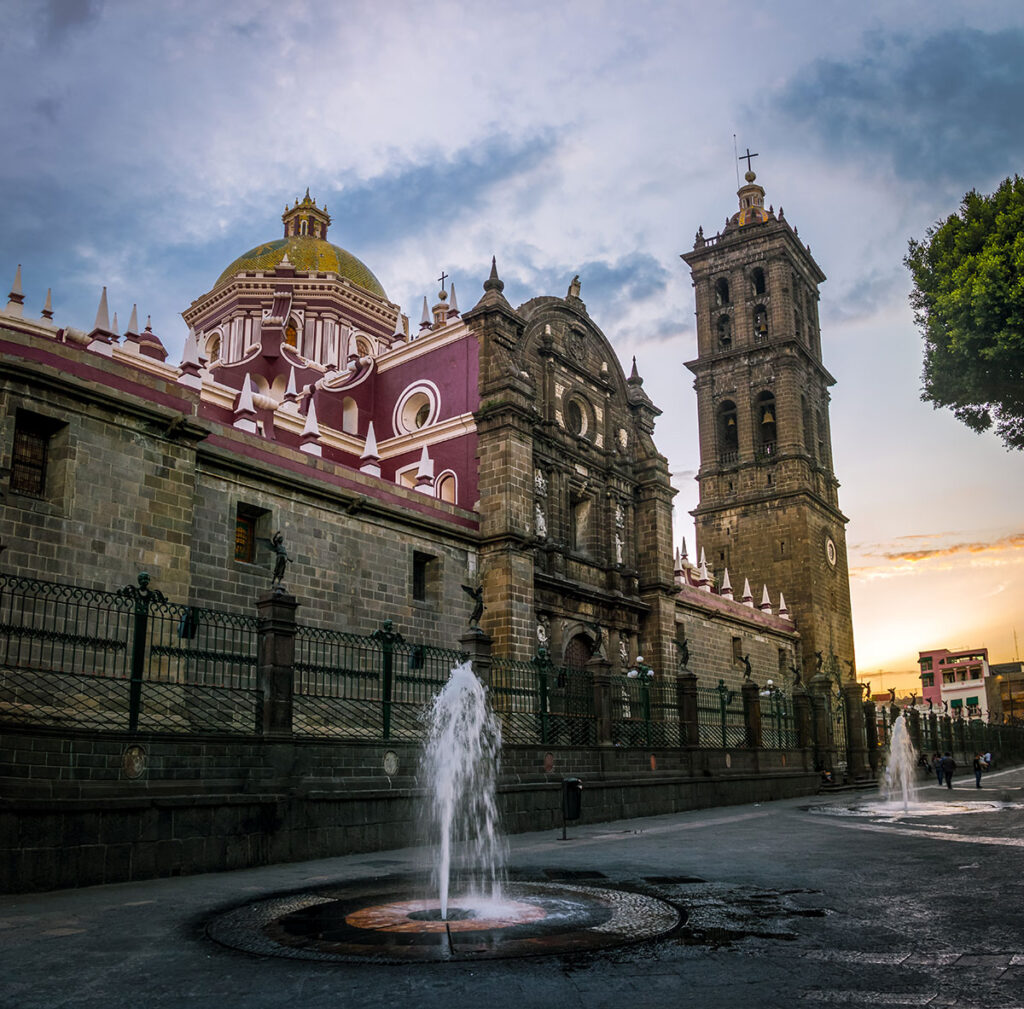
What Are the Best Attractions to See?
Puebla is a treasure trove of remarkable attractions that cater to a wide range of interests, from history and architecture to wildlife and panoramic views. Here are some of the must-see sites that make Puebla an unforgettable destination:
Puebla Cathedral: Dominating the city’s central square, the Puebla Cathedral is an architectural marvel that boasts towering spires and intricate interiors. Constructed over a span of several decades, this grand edifice is a testament to the city’s colonial heritage. Its stunning facade features detailed baroque and neoclassical elements, while the interior houses beautiful altars, artwork, and a massive pipe organ. The cathedral’s impressive height and elegant design make it a centerpiece of Puebla’s skyline.
Biblioteca Palafoxiana: As the oldest public library in the Americas, the Biblioteca Palafoxiana is a cultural and historical gem. Founded in 1646, it houses an extensive collection of rare books and manuscripts, many of which date back to the 15th century. The library’s beautifully preserved baroque interior, with its wooden bookshelves and ornate decor, offers a glimpse into the intellectual life of colonial Mexico. It remains a vital repository of knowledge and a fascinating destination for history and literature enthusiasts.
Cholula Pyramid: Located just outside Puebla, the Great Pyramid of Cholula is the largest pyramid by volume in the world. This ancient structure, partially covered by a hill and topped with a church, offers panoramic views of the surrounding landscape and the distant Popocatépetl volcano. Visitors can explore the network of tunnels within the pyramid and learn about its historical and cultural significance. The site also features a museum that provides insights into the pre-Columbian civilizations that once thrived in the region.
Africam Safari: For a unique wildlife experience, Africam Safari is a must-visit attraction. This expansive safari park, located a short drive from Puebla, allows visitors to see a wide variety of animals in settings that mimic their natural habitats. Guests can drive through the park or take guided tours to observe lions, giraffes, zebras, and other exotic species up close. The park’s conservation efforts and educational programs make it a fun and enlightening destination for families and animal lovers.
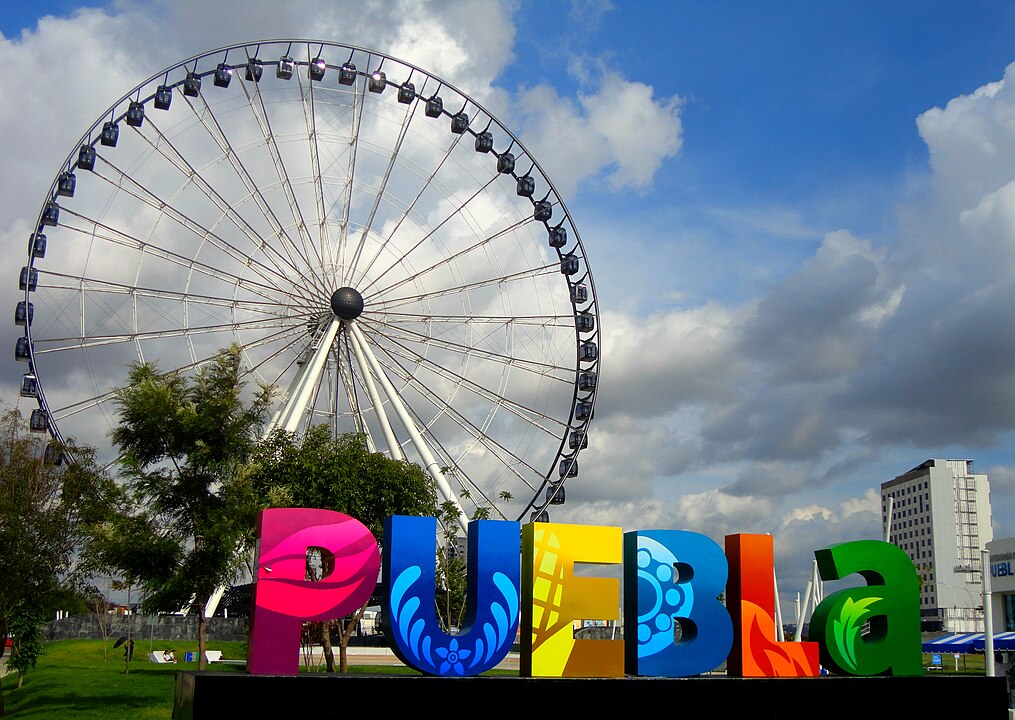
Estrella de Puebla: Offering breathtaking views of the city and its surroundings, the Estrella de Puebla is a giant Ferris wheel that stands as a modern icon of the city. Rising 80 meters above the ground, it provides a spectacular vantage point from which to admire Puebla’s historic skyline, the nearby mountains, and the sprawling urban landscape. A ride on the Estrella de Puebla is a perfect way to cap off a day of sightseeing, offering a serene and picturesque perspective of this vibrant city.
These attractions, each with its unique charm and significance, highlight the diverse appeal of Puebla. Whether you’re drawn to its historical landmarks, cultural institutions, or natural beauty, Puebla offers a rich and varied experience that is sure to captivate every visitor.
What Are the Best Places to Stay?
Puebla offers a range of accommodations that cater to various tastes and budgets, ensuring a comfortable and memorable stay for every traveler. Here are some of the best places to stay in Puebla, each offering unique features and exceptional service:
Hotel Cartesiano: Nestled in the heart of Puebla’s historic center, Hotel Cartesiano is a luxurious blend of modern comfort and historic charm. This upscale hotel occupies two beautifully restored colonial buildings, complemented by contemporary architecture. Guests can enjoy elegantly designed rooms with state-of-the-art amenities, a rooftop pool with stunning city views, and a tranquil courtyard. The hotel’s prime location makes it an ideal base for exploring Puebla’s cultural and historical attractions, while its attentive service ensures a relaxing and indulgent stay.
Casareyna Hotel: Known for its exquisite design and proximity to major attractions, Casareyna Hotel offers a sophisticated and welcoming environment. The hotel’s spacious suites feature traditional Talavera tilework and modern furnishings, creating a perfect blend of old and new. Guests can savor authentic Poblano cuisine at the on-site restaurant, which is highly regarded for its delicious mole poblano and other regional specialties. With its central location, Casareyna Hotel provides easy access to Puebla’s top sites, including the Puebla Cathedral and Biblioteca Palafoxiana.
El Sueño Hotel & Spa: For travelers seeking a serene retreat in the heart of the city, El Sueño Hotel & Spa is an excellent choice. This boutique hotel boasts individually decorated rooms, each inspired by a different dream or famous dreamer. The tranquil atmosphere extends to the hotel’s spa, where guests can indulge in a variety of treatments designed to rejuvenate the body and mind. A charming courtyard, complete with a fountain and lush greenery, offers a peaceful escape from the bustling city. El Sueño’s attentive staff and intimate setting make it a favorite among couples and solo travelers looking for a unique and restful experience.
These accommodations, with their distinct styles and offerings, provide a range of options for visitors to Puebla. Whether you prefer the historical elegance of Hotel Cartesiano, the design-centric comfort of Casareyna Hotel, the serene ambiance of El Sueño Hotel & Spa, or the luxury of Rosewood Puebla, you’re sure to find a perfect place to rest and recharge while exploring this enchanting city.
What Are the Best Festivals to Celebrate?
Puebla is a city that knows how to celebrate, with a vibrant calendar of festivals that reflect its rich cultural heritage and communal spirit. Here are some of the best festivals in Puebla, each offering a unique glimpse into the city’s traditions and lively atmosphere:
Cinco de Mayo: Perhaps the most internationally recognized of Puebla’s festivals, Cinco de Mayo commemorates the Battle of Puebla, where Mexican forces achieved a significant victory over the French on May 5, 1862. In Puebla, this day is marked by grand parades, colorful reenactments, and festive celebrations throughout the city. The historical reenactments bring the battle to life with detailed costumes and dramatic performances, while the parades showcase vibrant floats, traditional music, and dance. The city’s streets are filled with a joyful energy, making it a memorable time to experience Puebla’s patriotic pride and cultural exuberance.
Day of the Dead (Día de los Muertos): Celebrated from October 31 to November 2, the Day of the Dead is a deeply rooted tradition in Mexican culture, and Puebla’s observance of this holiday is particularly special. The city transforms into a colorful and heartfelt homage to departed loved ones, with elaborate altars (ofrendas) decorated with marigolds, candles, and photographs. Public spaces and homes alike are adorned with intricate papel picado (cut paper decorations) and sugar skulls. Parades and cultural events fill the streets, featuring traditional music, dance, and vibrant costumes. Visitors can also sample traditional foods like pan de muerto (bread of the dead) and atole, a warm, comforting beverage. The Day of the Dead in Puebla is a profound and beautiful celebration of life and memory.
Festival Internacional de Puebla: This annual festival is a spectacular showcase of music, dance, and theater from around the world. Held over several days, the Festival Internacional de Puebla transforms the city into a global stage, with performances by renowned artists and troupes. The festival’s diverse program includes everything from classical music concerts and ballet performances to contemporary dance and theatrical productions. Outdoor stages and historic venues throughout the city host these events, making it an immersive cultural experience. In addition to performances, the festival often features workshops, exhibitions, and street performances, inviting both locals and visitors to engage with the arts in a dynamic and interactive way.
Puebla’s festivals are a testament to its rich cultural tapestry and vibrant community spirit. Each celebration offers a unique opportunity to experience the city’s traditions, creativity, and joie de vivre. Whether you’re witnessing the historical significance of Cinco de Mayo, the heartfelt rituals of the Day of the Dead, or the artistic splendor of the Festival Internacional de Puebla, these events highlight the city’s ability to honor its past while embracing the present.
The History of Puebla
Puebla, known as Heroica Puebla de Zaragoza, is a city steeped in history and culture. Founded in the early 16th century, it has evolved into a vibrant metropolis that harmoniously blends its colonial past with modern development. The city’s history is marked by significant events and diverse influences that have shaped its identity over the centuries. From its indigenous roots to its colonial architecture, and from pivotal battles to contemporary achievements, Puebla stands as a testament to the resilience and creativity of its people.
Pre-Columbian Civilizations
Long before the arrival of Europeans, the region that is now Puebla was a thriving center of various indigenous civilizations, each contributing to its rich cultural tapestry. Among the most notable were:
Olmecs (1500–400 BC): Often referred to as the “mother culture” of Mesoamerica, the Olmecs were among the earliest significant civilizations in the region. They are renowned for their colossal head sculptures carved from stone, impressive artifacts that reflect their advanced artistic skills and complex society. The Olmecs laid the foundational cultural and religious elements that would influence later Mesoamerican civilizations.
Totonacs (600–1521 AD): The Totonacs were known for their advanced agricultural techniques, including terracing and irrigation, which supported their large settlements. They produced beautiful pottery and were skilled builders, constructing impressive structures in their cities. The Totonacs played a crucial role in the region’s economy and culture, and their influence extended well beyond their primary settlements.
Nahua (1200–1521 AD): The Nahua people, including the Mexica (Aztecs), were influential in the region, contributing significantly to its cultural and economic landscape. They were known for their elaborate religious ceremonies, rich mythology, and impressive architectural achievements. The Nahua’s social and political structures set the stage for the region’s development during the pre-Columbian era.
The Great Pyramid of Cholula: The city of Cholula, near modern-day Puebla, was a major pre-Columbian center. It is especially renowned for the Great Pyramid of Cholula, the largest pyramid by volume in the world. This ancient structure was not only a religious and ceremonial site but also a significant trade hub. The city’s sophisticated urban planning and architectural skills are evident in the pyramid’s design and construction, reflecting the advanced nature of the civilizations that inhabited the area.
The Founding of Puebla 1531
In 1531, the Spanish established the city of Puebla as a colonial settlement. Strategically located between the port of Veracruz and Mexico City, Puebla quickly became an important center for trade and culture. The city’s layout was meticulously planned, featuring a grid pattern that facilitated movement and commerce. Puebla’s founding marked the beginning of its transformation into a vibrant colonial city, blending European influences with the rich indigenous heritage of the region.
Battle of Puebla 1862
The Battle of Puebla on May 5, 1862, is a significant event in Mexican history. On this day, the Mexican army achieved a remarkable victory over the French forces, despite being outnumbered and less equipped. This triumph is commemorated annually as Cinco de Mayo, a celebration of Mexican resilience and pride. The victory at Puebla became a symbol of national unity and determination.
Modern Puebla
Today, Puebla is a dynamic city that seamlessly blends historical charm with modern development. It remains a key cultural and economic hub in Mexico, known for its rich culinary heritage, bustling markets, and welcoming atmosphere. Modern Puebla boasts a thriving economy, supported by industries such as automotive manufacturing, food production, and education. The city’s vibrant cultural scene, historic landmarks, and friendly locals make it a captivating destination for travelers and a beloved home for its residents.
FAQ
A: The best time to visit Puebla is during the spring (March to May) and autumn (September to November) months when the weather is mild and pleasant. These seasons also coincide with some of Puebla’s most vibrant festivals, such as Cinco de Mayo and the Day of the Dead, offering visitors a chance to experience the city’s rich cultural traditions. The mild temperatures during these periods make it ideal for exploring the city’s historic sites, bustling markets, and enjoying outdoor activities.
A: Puebla is easily accessible by various means of transportation. By road, it is approximately a two-hour drive from Mexico City, making it a convenient destination for those traveling from the capital. Puebla also has its own international airport, Hermanos Serdán International Airport (PBC), which offers flights from major cities in Mexico and select international destinations. Additionally, there are regular bus services from Mexico City and other nearby cities, providing comfortable and affordable travel options.
A: Yes, Puebla is generally safe for tourists, particularly in the main tourist areas such as the historic center, major attractions, and popular markets. Like any city, it is advisable to take common-sense precautions, such as avoiding poorly lit areas at night and keeping an eye on personal belongings. The local authorities are committed to maintaining a safe environment for visitors, and the city’s friendly residents are often more than willing to help with directions or recommendations.
A: Puebla is renowned for its rich tradition of artisanal crafts, making it a fantastic destination for unique souvenirs. Some of the most popular local crafts include:
Talavera Pottery: This beautifully decorated ceramic ware is one of Puebla’s most iconic crafts. Talavera pieces, ranging from plates and bowls to tiles and vases, are characterized by their intricate designs and vibrant colors, often reflecting traditional Mexican motifs.
Textiles: Puebla’s markets offer a variety of handcrafted textiles, including embroidered garments, shawls, and tablecloths. These textiles often feature colorful patterns and designs unique to the region.
Traditional Candies: Puebla is famous for its sweets, such as camotes (sweet potato candies) and borrachitos (liqueur-filled candies). These treats make for delicious and distinctive gifts.
Handmade Jewelry: Local artisans create beautiful jewelry using traditional techniques and materials, including silver, beads, and semi-precious stones. These pieces often reflect Puebla’s cultural heritage and make for exquisite keepsakes.
Exploring Puebla’s markets and artisan shops provides a wonderful opportunity to purchase these crafts while supporting local artisans and preserving the region’s cultural traditions.
Food From Puebla
Puebla is a gastronomic paradise, celebrated for its rich and diverse culinary traditions that have earned it a prominent place on the global culinary map. The city’s cuisine is a delightful blend of indigenous ingredients and Spanish influences, resulting in a unique array of flavors and dishes that are sure to tantalize any food lover’s palate. Here are some must-try specialties that define Puebla’s culinary heritage:
Exploring Puebla’s food scene is a journey through its history and culture, with each dish telling a story of the region’s past and present. Whether you’re dining in a traditional restaurant, sampling street food, or visiting local markets, the flavors of Puebla are sure to leave a lasting impression.
- Photo Credits:
- By Ger1010 – Own work, CC BY-SA 3.0, https://commons.wikimedia.org/w/index.php?curid=28570197
- By Sisgeo – Own work, CC BY-SA 4.0, https://commons.wikimedia.org/w/index.php?curid=132779041
- By Juan Carlos Fonseca Mata – Own work, CC BY-SA 4.0, https://commons.wikimedia.org/w/index.php?curid=80019450
- By Diego Delso, CC BY-SA 3.0, https://commons.wikimedia.org/w/index.php?curid=30797196
